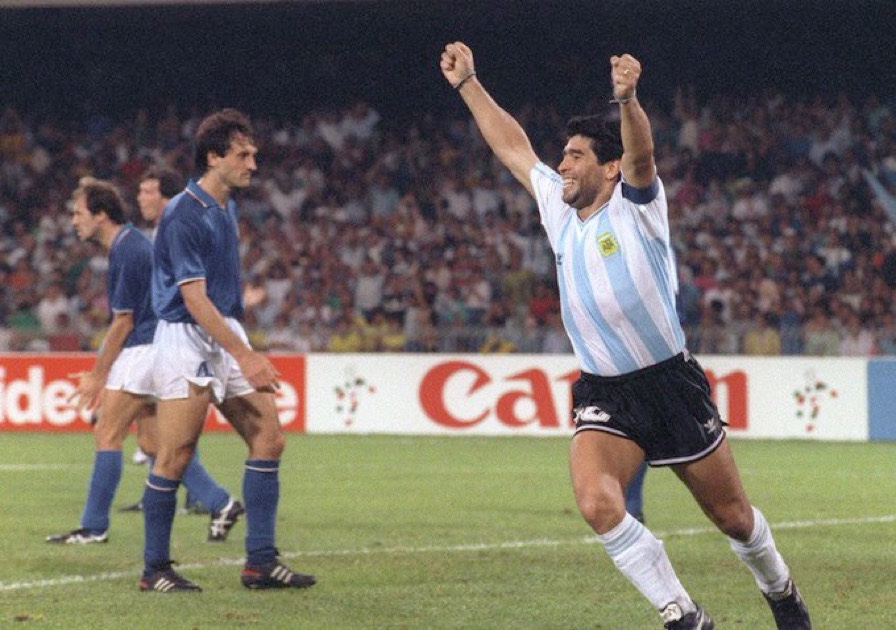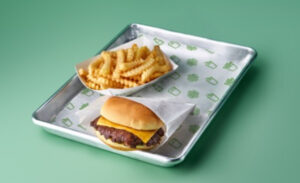Maradona’s Shirt? How About The Other 1986 World Cup Kits?

With Diego Maradona’s infamous match-worn ‘Hand of God’ shirt fetching a cool £7.1m at auction last week, demand for vintage football shirts has reached fever pitch. The Argentine’s 1986 World Cup shirt, previously owned by England midfielder Steve Hodge, has become the most expensive piece of match-worn sports memorabilia ever sold at auction. It beats out the sale of one of Babe Ruth’s shirts, which sold for £4.4m in 2019.
The sale of Maradona’s shirt caps a wider trend which has seen demand for classic football shirts from the 1980s and 90s rise significantly in recent years. Google search data highlights notable increases in searches for ‘cult kits,’ ‘vintage football shirts,’ and ‘classic football kits’ over the last five years.
The baggy fit and retro designs on these shirts has made them hugely popular with fans, who covet the outlandish designs that would never be produced by today’s shirt manufacturers. Perhaps this is why eBay searches for ‘retro football shirts’ increased by 136% in 2021. Like most items produced in the 1980s, however, these shirts tend to have aged either brilliantly or horribly.
In honour of the sale of Maradona’s shirt, we asked the design experts at print and branding giants Solopress to analyse the shirts worn at the 1986 World Cup, and pick out the best – and worst – designs. Just remember, it was the 80s – V-necks were in!
Key Findings:
• Diego Maradona’s match-worn ‘Hand of God’ shirt recently sold for £7.1m at auction.
• It became the most expensive match-worn item of sports memorabilia in history, beating one of Babe Ruth’s shirts, which sold for £4.4m in 2019.
• Recent demand for football shirts has been growing rapidly over the past five years, evidenced by increases in search volume for the terms ‘cult kits,’ ‘vintage football shirts,’ and ‘classic football kits.’
• In 2021, in the wake of the European Championships, eBay search data saw searches for ‘retro football shirts’ increase by 136%.
• The average selling price of a second-hand football shirt increased by 25% between 2020 and 2021.
• Solopress’s design experts found that Algeria and Denmark had the best-designed kits at the 1986 World Cup.
Algeria
Pros:
This shirt is well-designed and was one of the standouts at the 1986 World Cup. The colour scheme is clean and simple, which sounds as though it would be defined by the country’s flag, but even the simplest colour scheme can be ruined by a poor design.
The asymmetrical stripes and varied stripe weights add a nice level of detail to the shirt’s design without being overbearing, keeping it interesting but not intrusive. Plus, by moving the manufacturer’s logo to the sleeve, this shirt affords more attention to the Arabic ‘Algeria’ text. The design is uncluttered and clean.
Cons:
This kit is revered – its design has few flaws, and even fewer detractors. However, a well-designed kit didn’t prevent Algeria from crashing out of the tournament at the first hurdle.
Tournament performance:
Despite a goal from star striker Djamel Zidane earning a draw with Northern Ireland, the Fennec Foxes fell to a 3-0 defeat against Spain and 1-0 defeat against Brazil to exit the tournament in the group stages.
Fun fact:
This kit was made by local Algerian manufacturer Sonitex.
Iraq
Pros:
The Iraq kits from the 1986 World Cup both employed a strong colour scheme. The home kit’s strong contrast between the yellow shirt and black detailing works well with the classic Adidas sleeve stripes and provided a solid foil for the calmer sky blue away kit.
Cons:
However, the kit was adorned with squiggly lines that gave the shirt a cheap, shiny look without adding any notable design changes. The decision was also made to move the crest to the centre of the shirt and include block text saying ‘IRAQ’ where the badge normally is. It looks strange and out of place. The IRAQ text would have looked far better in the centre of the shirt.
Tournament Performance:
Iraq made their one and only World Cup appearance at this tournament. They failed to win a game, only scoring once through striker Ahmed Rahdi.
Fun fact:
The Iraq team controversially had a goal disallowed vs Paraguay when the referee blew for half-time a split-second before a goal was scored.
Denmark
Pros:
Denmark’s 1986 World Cup shirt was made by Hummel and broke all the rules with an eye-catching design that combined candy cane red and white stripes, quadrants, and sleeve chevrons. It became one of the most iconic shirts of all time.
Cons:
However, the shirt was not loved by all and had its fair share of detractors, who felt it was too loud and too garish. The shirt also opened the door for football teams to take more risks with their kit designs, which resulted in some of the ugliest shirts ever being produced in the 1990s.
Tournament Performance:
The Denmark team made it out of their group with a strong set of performances, beating previous finalists West Germany, Scotland, and Uruguay. They were hammered 5-1 by Spain in the round of 16, crashing out unceremoniously.
Fun fact:
This was Denmark’s first appearance at the World Cup. In the years since, they have performed well in international tournaments, reaching the semi-finals of Euro 2021 before being dramatically knocked out by England. The Scandinavians won the European Championship in 1992 as major underdogs.
Canada
Pros:
In a vacuum, this isn’t a bad kit design. It bears the hallmarks of a strong 80s kit; the red and white colour scheme gives the kit a lot to work with, and the colour detailing on the collar is a nice touch.
Cons:
However, it’s seriously uninspired. The kit is almost a carbon copy of the iconic Liverpool kits from the early 80s, but with the Reds’ ‘CANDY’ sponsor replaced with ‘CANADA.’ Being their first appearance at a World Cup, they could have tried to make more of a statement. This lukewarm kit only served to announce the Canadian team’s mediocrity before the tournament even kicked off.
Tournament Performance:
In their only WC appearance, Canada failed to win a game, losing 2-0 to the USSR, 2-0 to Hungary, and 1-0 to France.
Fun fact:
Canada will return to the World Cup for the first time in 2022, with a host of the World’s most promising young footballers in their line-up.
Scotland
Pros:
This Scotland shirt was one of the best of the tournament. With a tonal, understated striped pattern, accents of white piping on the sleeves and cuffs on the neck and sleeve, this shirt was tidy and well-designed.
Cons:
An incredibly unfashionable horizontal stripe across the shorts let this kit down. It looked bizarre, and somehow made the short shorts of the 1980s look even shorter. If they’d kept the shorts a single colour, it would’ve been an even greater design!
Tournament Performance:
In a tough group, Scotland drew once and lost twice, scoring just once, as Gordon Strachan scored in a 2-1 defeat to eventual finalists, West Germany.
Fun fact:
Sir Alex Ferguson was the manager of this Scotland team before taking the role as manager of Manchester United after the tournament.
England
Pros:
This shirt is classic, believed by many to be the best England shirt of all time. Subtle details help keep the kit design interesting, like the subtle tonal vertical stripes, and navy piping on the shoulders. A navy trim and a tasteful red contrast stitch round off this iconic kit.
Cons:
Despite the success of this shirt, the accompanying sky-blue shorts split opinion and had their fair share of detractors.
Tournament Performance:
England controversially fell to eventual winners Argentina in the quarter-finals, as Diego Maradona scored the infamous ‘Hand of God’ goal, and followed it up with a stunning solo effort which is considered by many to be the goal of the century.
Fun Fact:
Current Match of the Day presenter Gary Lineker won the tournament’s Golden Boot with six goals.
Argentina
Pros:
This kit has achieved iconic status in recent years. The home kit is beautiful – the black blocky typeface against the white and sky blue stripes looks stunning, the neckline isn’t too intrusive, and the pairing of the slightly raised badge and black Le Coq Sportif logo is an amazing combination.
Cons:
The away kit doesn’t hold up to the same design standards, with an overly deep V-neck collar and huge trim. As you can see from pictures taken during the World Cup, the Argentina crest isn’t adorning Maradona’s chest, but is closer to his shoulder blade. The badge also looks a little too big for the shirt, particularly by today’s standards.
Tournament Performance:
3-2 winners of an epic final with West Germany, Argentina won the World Cup, bringing home their second trophy.
Fun fact:
Diego Maradona won the Golden Ball for the tournament’s best player with five goals and five assists.
So, though Argentina’s 1986 away kit may be one of the most iconic and universally known kits of all time, Solopress’s design experts don’t see it that way. Glen Eckett, Solopress Head of Marketing, commented: ‘some vintage shirts are loved and coveted because of their unique design properties, like those worn by Algeria and Denmark, whilst Argentina’s home kit is a majesty of clean minimal design. As a design, the away kit simply doesn’t hold up as well, apart from the memorability of the match it was worn in.’
Maradona’s shirt has occupied the National Football Museum in Manchester for the last 20 years,
having been loaned there by its previous owner Steve Hodge. Now, having been bought by an enigmatic buyer, whose identity has yet to be revealed, the shirt’s fate remains unknown. We only hope it remains in the public eye, where people can enjoy such a key part of football history.




